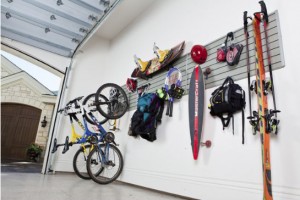Clear some space and mark off zones
To keep your job organised, you might want to create as much empty space as possible in the middle of the garage floor. Consider moving the car and other large, bulky items, such as the lawn mower and bicycles, out of the garage. I suggest dividing the garage into six sections: donate, sell, toss, keep, return to someone else, and undecided. You can mark off each section with blue painter’s tape or coloured chalk. It is helpful to save room on the floor for a staging area where you can place all items from one category before you make any decisions.
Work on one category at a time
I recommend picking a category, perhaps Christmas decorations, and then pulling every item from that category out of hiding and placing it in the staging area. Don’t forget about belongings stored in the rafters. Try to make a decision on each item in your category before moving on to the next one. If you really can’t decide, place the item in the ‘undecided’ pile. However, try not to put too much in this pile, because it will only delay the decluttering process.
Expect sorting of family members’ items to go slower
Children who are grown and have permanently moved out of the house often think of their parents’ home as a storage unit. This also can be true for an ex-spouse who has moved out of the family home. You are unlikely to have room to store other people’s belongings in your smaller space. Unfortunately, dealing with other family members can sometimes be emotionally taxing. Because of that, I recommend you tackle these items last. That way, you can plow full steam ahead on culling your own belongings and not let any potentially difficult conversations slow you down.
Keep your goals in mind
If you have trouble making decisions to let go of some items, it can sometimes be helpful to envision your new uncluttered space. To quote Marie Kondo’s best-selling book The Life-Changing Magic of Tidying Up, only keep items that “spark joy.” If you don’t truly love something or actually need it then, it is time to bid it goodbye.
Below are some common categories you might be tackling, as well as suggestions on what to keep and what to let go.
Browse more beautifully appointed garages

1. Sports equipment, camping gear, beach chairs and old bikes
Move all sports-related items into your staging area and take a serious look at the things in this category, considering whether you will ever use them again. Yes, it was fun to go camping when the kids were young, but do you really plan to go again? Although I love to be outdoors in a beautiful natural setting, at this stage of my life I also love to retreat to a comfortable bed at night. The same goes for bikes, beach chairs, golf clubs, tennis rackets and ski equipment. Try to remember the last time you used each item. If you golf twice a month, then by all means keep your golf clubs. If the last time you used your clubs was in the late 1980s, it might be time to let them go.Sports equipment, bikes and camping gear are popular items left behind by family members who have moved out. If that’s the case in your home, take all these items and move them to the ‘return to someone else’ section of your garage. Set a time when the belongings can be retrieved. If family members live out of the area, send pictures of the items and ask them whether you can get rid of them. Consider setting a date for the family members to pick up their belongings they decide to keep.










